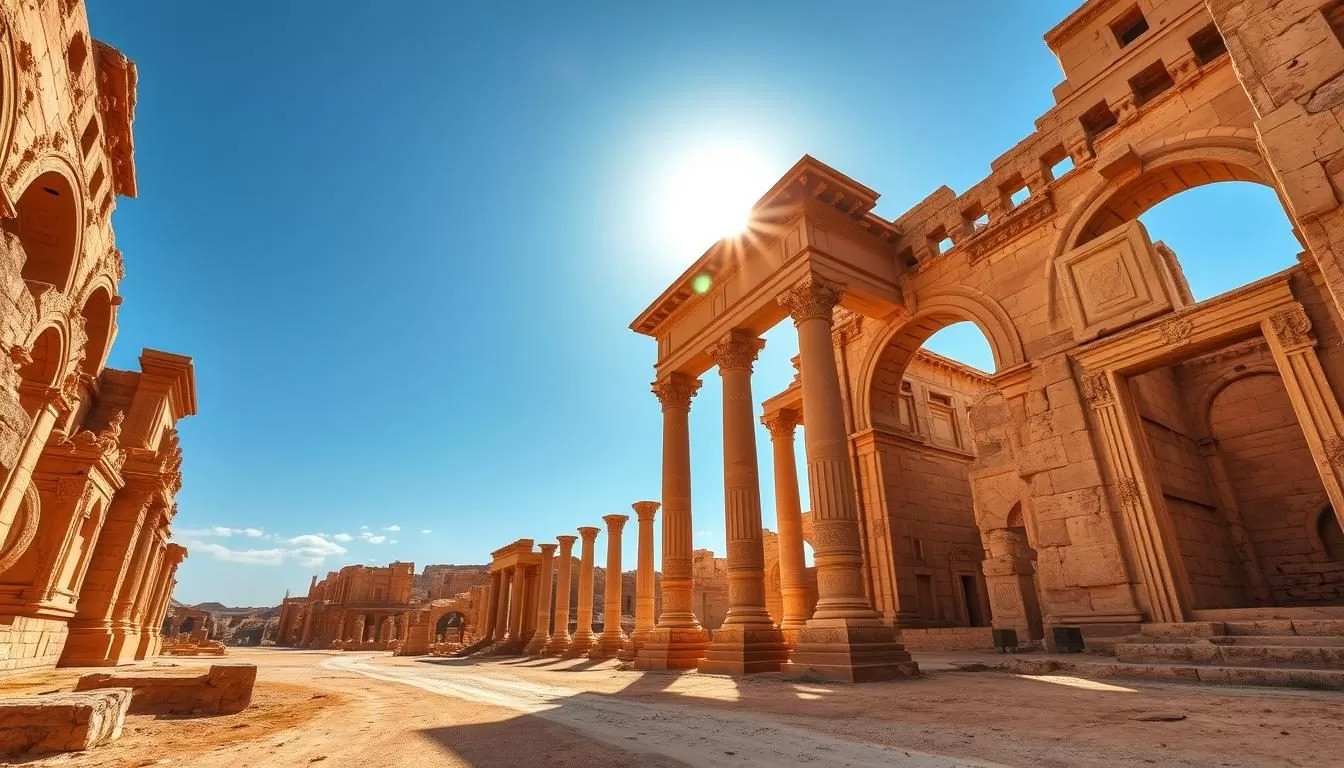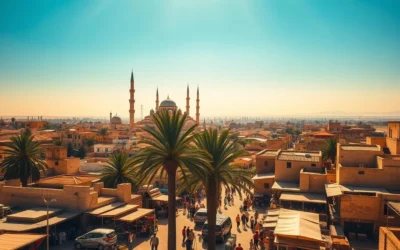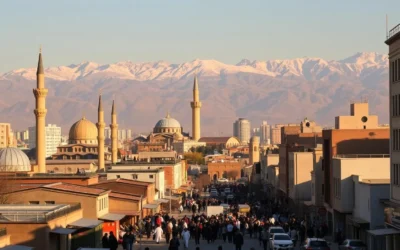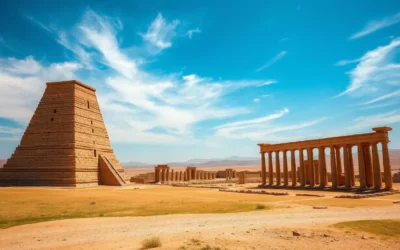✓ Accommodations✓ Flights✓ Rental Cars
Step into a place where history comes alive. Hatra, a UNESCO World Heritage Site, is a treasure trove of ancient ruins and statues that tell the story of the Parthian Empire. This city is a must-visit for anyone fascinated by the world’s rich cultural heritage.
Walking through Hatra feels like traveling back in time. The unique architecture and well-preserved landmarks offer a glimpse into a bygone era. Whether you’re on a tour or exploring on your own, this site promises an unforgettable trip filled with discovery.
From its grand temples to intricate carvings, Hatra is a guide to the past. It’s a place where every corner holds a story, making it a top destination for travel enthusiasts. Plan your visit today and experience the charm of this ancient city.
Introduction to Hatra, Iraq: Uncover the Ancient Gem
Discover a timeless treasure where history whispers through ancient stones. This city, a UNESCO World Heritage Site, offers a glimpse into the past like no other. Its unique blend of Greco-Roman and Parthian architecture makes it a must-visit location for anyone fascinated by the world’s cultural heritage.
Historical Overview and Cultural Significance
Hatra was once a thriving city during the Parthian Empire, serving as a vital trade and religious hub. Its well-preserved ruins reflect a fusion of Hellenistic and Oriental styles, showcasing the history of a bygone era. The site is a testament to the ingenuity and artistry of its people, making it a cornerstone of cultural heritage in the region.
As a UNESCO World Heritage Site, Hatra stands as a symbol of resilience and cultural richness. Its sculptural ruins and grand temples tell stories of a time when this place was a center of power and spirituality. Walking through its ancient streets, you’ll feel connected to the past in a profound way.
Why You Should Explore Hatra Today
Hatra is more than just an archaeological site; it’s a journey through history. For visitors, it offers a chance to explore a location that has shaped the cultural landscape of the world. Whether you’re a history buff or a curious traveler, this place promises an unforgettable trip filled with discovery.
“Hatra is a living testament to the enduring legacy of ancient civilizations.”
Plan your visit today and experience the charm of this ancient city. From its grand temples to its intricate carvings, Hatra is a guide to the past and a treasure for the future.
Hatra, Iraq: Best Things to Do – Top Picks
Uncover the secrets of a place that has stood the test of time. This ancient city offers a unique blend of history and culture, making it a must-visit destination for travelers. From grand temples to scenic ruins, there’s a lot to explore here.
Start your journey at the Great Temple Complex, where towering iwans and intricate carvings showcase the advanced engineering of the time. This site is a testament to the ingenuity of its people and a highlight of any tour.
For a deeper understanding of the region, visit the Erbil Civilization Museum. Here, you’ll find preserved limestone statues of King Sanatruq I, offering a glimpse into the history of this ancient city.
Take a stroll along the impressive city walls, where you can soak in the panoramic views of the surrounding landscape. It’s a perfect way to connect with the past while enjoying the beauty of the world around you.
Here’s a quick guide to the top activities you shouldn’t miss:
| Activity | Highlights |
|---|---|
| Great Temple Complex | Towering iwans, intricate carvings, and advanced engineering. |
| Erbil Civilization Museum | Preserved statues of King Sanatruq I and historical artifacts. |
| City Walls Walk | Panoramic views and a connection to ancient history. |
Whether you’re planning a day trip or a longer stay, this place promises an unforgettable trip. Don’t forget to check the latest travel advisories and prepare for a visible military presence at the site.
Discover the Great Temple Complex
Immerse yourself in the grandeur of an ancient marvel. The Great Temple Complex is the heart of this place, showcasing a blend of artistic influences that make it a remarkable piece of ancient engineering. This site is a must-see for anyone fascinated by the world’s rich cultural heritage.
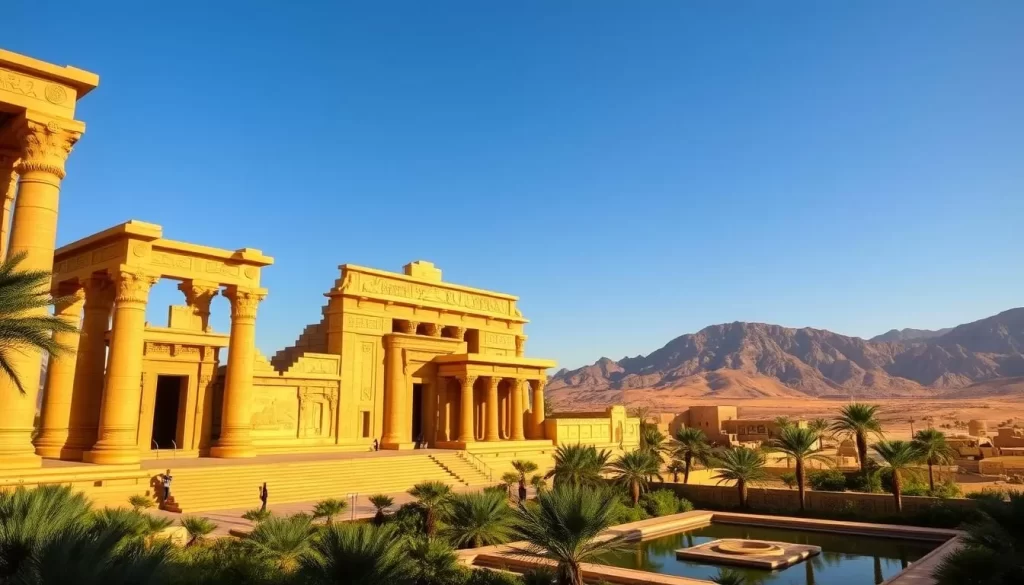
Temple of Shamash and its Mystique
The Temple of Shamash is celebrated for its impressive vaulted halls and intricate carvings of deities. This location reflects the advanced architectural knowledge of its time, offering a glimpse into the history of a bygone era. As you explore, you’ll feel the mystique that surrounds this sacred place.
Exploring the Temple of the Triad
The Temple of the Triad is another highlight of the complex, known for its cultural importance and unique design. This site features a blend of Hellenistic and Eastern styles, making it a cornerstone of the region’s heritage. Take your time to admire the intricate details that tell stories of ancient spirituality.
Here’s a quick guide to make the most of your visit:
| Activity | Highlights |
|---|---|
| Temple of Shamash | Vaulted halls, deity carvings, and architectural brilliance. |
| Temple of the Triad | Cultural significance and unique artistic fusion. |
| Photo Opportunities | Capture the intricate details and panoramic views. |
For the best experience, visit early in the morning or late afternoon to avoid the heat. Don’t forget to bring a guide or map to navigate this expansive site with ease. Plan your trip today and uncover the secrets of this ancient city.
Experience Unique Architectural Marvels
Step into a world where ancient artistry meets timeless innovation. The ruins of this city showcase a remarkable fusion of Hellenistic and Oriental styles, making it a must-see for anyone fascinated by architectural history. Every corner of this place tells a story of cultural exchange and artistic brilliance.
Hellenistic and Oriental Fusion in Stone
The architectural designs here are a testament to the ingenuity of ancient builders. The fine stonework and innovative designs set these ruins apart from other ancient sites worldwide. You’ll notice intricate carvings and grand structures that reflect a blend of Eastern and Western influences.
This region was once a crossroads of cultures, and its architecture tells that story. The fusion of styles is not just visually stunning but also historically significant. It’s a way to connect with the past and appreciate the artistry of a bygone era.
Here’s what to look for during your tour:
- Intricate carvings that blend Hellenistic and Oriental motifs.
- Grand structures that showcase advanced engineering techniques.
- Unique designs that reflect the cultural diversity of the area.
Take your time to explore these marvels. A knowledgeable guide can help you uncover the hidden details that make this place so special. Whether you’re a history buff or a casual traveler, this site promises an unforgettable trip.
Unraveling Hatra’s Historical Significance
Delve into the spiritual heart of an ancient civilization. This place was once a thriving center of religious life, where the spiritual beliefs of its people shaped its identity. Today, its ruins offer a glimpse into the past, revealing a city deeply connected to its cultural roots.
Ancient Religious Heritage
Hatra’s ruins are a testament to its role as a hub of ancient spirituality. The site is filled with artifacts that reflect the religious practices of its time. From intricate carvings to grand temples, every detail tells a story of devotion and cultural richness.
As you explore, you’ll notice how the region was shaped by its spiritual heritage. The fusion of Hellenistic and Oriental styles in its architecture highlights the diverse influences that defined this location. It’s a way to connect with the past and understand the beliefs that guided its people.
Here’s what makes Hatra’s religious heritage so unique:
- Its grand temples served as centers of worship and community life.
- Artifacts found on site provide insights into ancient rituals and beliefs.
- The fusion of architectural styles reflects its role as a crossroads of cultures.
For visitors, this place offers a chance to step back in time and experience the spiritual essence of an ancient city. Whether you’re a history enthusiast or a curious traveler, Hatra’s religious heritage promises an unforgettable trip into the past.
Navigating Transportation and Entry Requirements
Prepare for an adventure that combines history and modern travel logistics. Getting to this ancient city requires careful planning, especially when it comes to transportation and entry permits. Whether you’re traveling by shared taxi or private vehicle, understanding the way to navigate checkpoints and secure necessary documents is essential for a smooth trip.
Getting to Hatra: Shared Taxis, Private Drives, and Checkpoints
Shared taxis are a popular and affordable option for reaching this place. From Baghdad, a shared taxi ride costs around 15,000 IQD ($10) and takes about 1.5 hours. Private drives offer more flexibility but require navigating multiple checkpoints. Be prepared for visible military presence and security checks along the way.
If you’re traveling from Erbil, a minibus ride costs approximately 5,000 IQD ($3.50) per person. This route is scenic but can be time-consuming, so plan your day accordingly. Always carry your passport and any required permits to avoid delays at checkpoints.
Visa and Permit Essentials for US Travelers
US citizens can obtain a visa on arrival, which costs between $75 and $80. No Iraqi visa is needed for stays shorter than 15 days in Iraqi Kurdistan. Ensure your passport is valid for at least six months from your entry date.
For a hassle-free experience, consider hiring a local guide who can assist with permits and security arrangements. This is especially helpful if you’re visiting multiple sites in the area.
Here’s a quick checklist for your journey:
- Bring cash, as ATMs in Iraq do not work with US banks.
- Carry a printed copy of your visa and permits.
- Plan for extra time at checkpoints due to security measures.
With these tips, you’ll be well-prepared to explore this ancient city and its rich history. Safe travels!
Planning the Perfect Time to Visit
Timing your visit can make all the difference in exploring this ancient site. Spring and fall are the best seasons to experience the place, with milder temperatures ranging from 15-25°C (59-77°F). These months are ideal for walking through the ruins and soaking in the history without the discomfort of extreme heat.
Summer months, from April to October, can be challenging with temperatures soaring between 30-50°C (86-122°F). If you plan to visit during this time, start your trip early in the morning or late afternoon to avoid the midday sun. Staying hydrated and wearing light clothing are essential tips for a comfortable experience.
Winter is another option, but the cooler weather may limit your time outdoors. Regardless of the season, check the operational hours of the location and plan your itinerary accordingly. Local events and festivals can also enhance your visit, so research ahead to make the most of your travel.
Here’s a quick guide to help you decide:
- Spring (March-May): Mild weather, perfect for exploring the ruins.
- Fall (September-November): Comfortable temperatures and fewer crowds.
- Summer (June-August): Early mornings or late afternoons are best.
- Winter (December-February): Cooler but still manageable with proper planning.
By choosing the right time, you’ll enjoy a more immersive and pleasant experience in this historic city. Whether you’re a solo traveler or part of a group, these tips will help you make the most of your trip.
Strolling Along Hatra’s Impressive City Walls
Embark on a journey through time as you explore the ancient city walls of Hatra. These towering structures, built over 2,000 years ago, offer a unique way to connect with the past. Each step along the walls takes you deeper into the history of this remarkable place.
The walls were not just a defensive structure but also a symbol of the city’s resilience. They protected the site from invasions and stood as a testament to the ingenuity of its builders. Today, they provide a scenic walk with panoramic views of the surrounding area.
Walk Through Time and History
As you stroll along the walls, you’ll notice the intricate architecture that blends Hellenistic and Oriental styles. This fusion reflects the cultural diversity of the region during its peak. The walls are a living reminder of a time when this city was a thriving hub of trade and spirituality.
For the best experience, visit early in the morning or late afternoon. The soft light during these times enhances the beauty of the ruins and makes for stunning photographs. Don’t forget to bring a guide or map to navigate the site with ease.
Here’s a quick guide to make the most of your visit:
| Activity | Highlights |
|---|---|
| Morning Walk | Soft light for photography and cooler temperatures. |
| Afternoon Stroll | Panoramic views and a peaceful atmosphere. |
| Historical Insights | Learn about the defensive purpose and cultural significance. |
Whether you’re a history enthusiast or a casual traveler, this place promises an unforgettable trip into the past. Plan your visit today and experience the charm of these ancient walls.
Capturing Photo-Worthy Spots and Scenic Views
Capture the essence of an ancient world through your lens. The ruins of this city offer countless opportunities for stunning photographs. Every corner of this place tells a story, making it a paradise for photographers and history enthusiasts alike.

Top Angles Around Ancient Ruins
For the best shots, focus on the intricate details of the architecture. The grand temples and towering walls provide a dramatic backdrop. Early morning or late afternoon light enhances the textures and shadows, adding depth to your photos.
Local guides can help you discover hidden gems and unique perspectives. They know the best spots and can share insights into the history of each structure. This makes your trip not just visually rewarding but also educational.
Here are some tips to make the most of your photography experience:
- Use wide-angle lenses to capture the grandeur of the ruins.
- Experiment with different angles to highlight the architecture.
- Visit during golden hours for the best natural lighting.
For a deeper understanding of the area, consider joining a guided tour. These tours often include stops at lesser-known but equally stunning locations. You’ll gain a richer appreciation for the past while documenting your journey.
| Photography Tips | Highlights |
|---|---|
| Wide-Angle Shots | Capture the vastness of the site and its architecture. |
| Golden Hour | Soft, warm light enhances textures and details. |
| Local Guides | Insider tips for unique perspectives and hidden spots. |
For more insights on independent travel in Iraq, check out this comprehensive guide. It’s a great resource for planning your trip and making the most of your visit to this historic place.
Join a Guided Tour for Deeper Insights
Unlock the secrets of an ancient world with a guided tour. Exploring this historic place with a local guide offers a richer understanding of its culture and history. You’ll gain access to hidden details and stories that bring the city to life.
Local experts provide unique perspectives that you might miss on your own. They share insights into the architecture, traditions, and events that shaped this place. Whether you’re a history enthusiast or a casual traveler, a guided tour enhances your experience.
Local Experts and Tour Group Benefits
One of the biggest advantages of a guided tour is the expertise of your guide. They know the best routes, the most significant structures, and the stories behind them. This makes your trip not just informative but also engaging.
Group tours also offer a sense of security, especially in areas with visible military presence. You’ll navigate checkpoints more smoothly, and your guide will handle any logistics. This allows you to focus on enjoying the site without worrying about security.
Here’s what you can expect from a guided tour:
- Access to restricted areas that are off-limits to independent travelers.
- Insider tips on the best times to visit popular locations.
- Stories and anecdotes that bring the city’s history to life.
For a truly immersive experience, consider joining a guided tour when exploring the Iraqi Marshlands. It’s a way to connect with the past while ensuring a safe and enriching trip.
“A guided tour is more than just a walk through history; it’s a journey into the heart of a culture.”
Whether you’re traveling solo or with a group, a guided tour offers a unique way to explore this ancient city. Plan your visit today and discover the stories that make this place so special.
Embracing Safety and Cultural Etiquette
Understanding local customs and safety measures is key to enjoying your visit to this historic place. Respecting the culture and traditions of the area ensures a smooth and enriching trip. Here’s how you can make the most of your experience while staying mindful of local norms.
Practical Tips for Respectful Interaction
When visiting religious or historical sites, dress modestly to show respect. Avoid wearing revealing clothing, and consider covering your shoulders and knees. This small gesture goes a long way in honoring the local culture.
Always ask for permission before taking photos of people or sacred structures. Some areas may have restrictions on photography, so it’s best to check with your guide or local authorities. This ensures you don’t unintentionally offend anyone.
Interacting with residents politely is another way to show respect. A simple greeting in the local language can make a big difference. It’s a great way to connect with the community and learn more about their way of life.
Here’s a quick guide to help you navigate cultural etiquette:
| Tip | Why It’s Important |
|---|---|
| Dress modestly | Shows respect for religious and cultural norms. |
| Ask before taking photos | Protects privacy and sacred spaces. |
| Learn basic greetings | Builds rapport with locals and enhances your experience. |
By following these tips, you’ll ensure a safe and culturally sensitive visit. Whether you’re exploring ancient ruins or interacting with locals, these practices will help you make the most of your trip.
Finding Local Accommodation and Dining Options
Planning your stay and meals is an essential part of any trip to this historic region. Whether you’re looking for a luxurious hotel or a cozy homestay, there are plenty of options to suit your needs. Nearby cities like Mosul and Baghdad offer a range of accommodations, making it easy to find the perfect place to rest after a day of exploration.
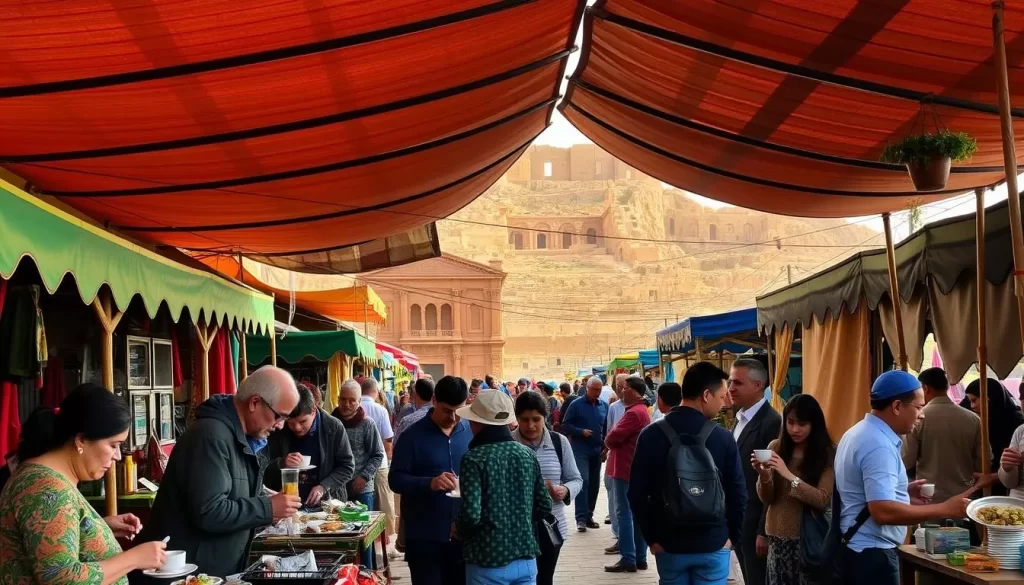
Where to Stay: From Hotels to Homestays
For those seeking comfort and convenience, hotels in Mosul and Baghdad provide modern amenities and easy access to cultural sites. Luxury options like the Babylon Rotana and Coral Baghdad Hotel are perfect for travelers who want to indulge. Budget-friendly choices, such as the Palm Beach Hotel, offer great value without compromising on quality.
If you’re looking for a more immersive experience, consider staying in a homestay. This way, you’ll get a chance to connect with locals and learn about their daily lives. Many homestays are located in charming neighborhoods, giving you a unique perspective on the city.
Savoring Authentic Iraqi Cuisine Nearby
No trip is complete without tasting the local flavors. Iraqi cuisine is rich and diverse, with dishes like masgouf (grilled fish), dolma (stuffed vegetables), and kebabs that are sure to delight your taste buds. Restaurants like Shanasheel Palace Hotel and Shabandar Cafe are popular spots for authentic meals, offering a blend of tradition and hospitality.
For a quick bite, street food vendors are a great option. You’ll find affordable and delicious meals that are perfect for a busy day of sightseeing. Don’t forget to try local sweets and tea, which are an integral part of the dining experience.
When planning your trip, consider booking your stay in advance, especially during peak seasons. This ensures you have a comfortable place to return to after a long day of exploring. For more tips on backpacking in Iraq, check out this comprehensive guide.
Diving into Hatra’s Vivacious History and Culture
Explore the vibrant tapestry of history and culture that defines this ancient city. Once a thriving religious center during the Parthian Empire, this place flourished between the 1st and 3rd centuries AD. Its ruins tell stories of resilience, artistry, and a time when it was a hub of spirituality and trade.
Walking through the site, you’ll notice the intricate blend of architectural styles. This fusion reflects the cultural diversity that shaped the region during its peak. From grand temples to detailed carvings, every detail offers a glimpse into the past.
Today, this city continues to captivate visitors with its living legacy. Despite facing destruction over the centuries, including recent damage, efforts are underway to restore and preserve its historical significance. This makes it a must-visit for anyone seeking a deeper connection to history.
Here’s what makes this place so special:
- Its role as a religious center during the Parthian Empire.
- The blend of architectural styles that showcase cultural diversity.
- Ongoing restoration efforts that highlight its enduring importance.
For tourists, this experience is more than just a trip; it’s a journey through time. Whether you’re exploring the ruins or learning about its history, this city offers a unique way to connect with the past.
As you plan your visit, consider the cultural practices that continue to shape the local community. Respecting these traditions ensures a meaningful and enriching experience.
Exploring Attractions Around Hatra
Expand your adventure beyond the ancient ruins with nearby attractions that offer a mix of history and natural beauty. From archaeological sites to stunning landscapes, there’s plenty to explore in this region. Whether you’re a history enthusiast or a nature lover, these destinations promise an enriching trip.
Day Trips and Nearby Historic Sites
Start your journey with a visit to the Mesopotamian marshes, a UNESCO World Heritage Site. This unique ecosystem offers a glimpse into the past and present of the area. A boat trip through the marshes costs around 25,000 to 35,000 IQD, providing an unforgettable experience.
For history buffs, the Ziggurat of Ur is a must-see. This 4,000-year-old structure stands as a testament to ancient Sumerian ingenuity. The entrance fee is 25,000 IQD, making it an affordable addition to your itinerary.
Another highlight is the Great Mosque of Samarra, known for its iconic spiral minaret. The journey from Baghdad takes about 1.5 hours and costs 15,000 IQD. Don’t forget to pay the 25,000 IQD entrance fee to explore this architectural marvel.
Travel Tips for a Smooth Experience
When planning your trip, consider the logistics of moving between sites. Shared taxis are a cost-effective option, with fares ranging from 10,000 to 25,000 IQD depending on the distance. Always carry cash, as ATMs in the region may not accept foreign cards.
Security is a priority, so expect visible military presence and checkpoints along the way. Having a local guide can help navigate these areas smoothly and provide valuable information about the sites.
For a deeper dive into the local culture, consider joining a guided tour. These often include meals with Iraqi families, offering a taste of authentic cuisine and hospitality.
Ready to explore these diverse locations? Plan your visit today and uncover the hidden gems that make this region so special.
Unearthing Archaeological Treasures and Artifacts
Journey into the heart of ancient discoveries and uncover the stories hidden within the ruins. This place is a treasure trove of artifacts that testify to a once-great civilization. From intricate carvings to grand structures, every find offers a glimpse into the past.
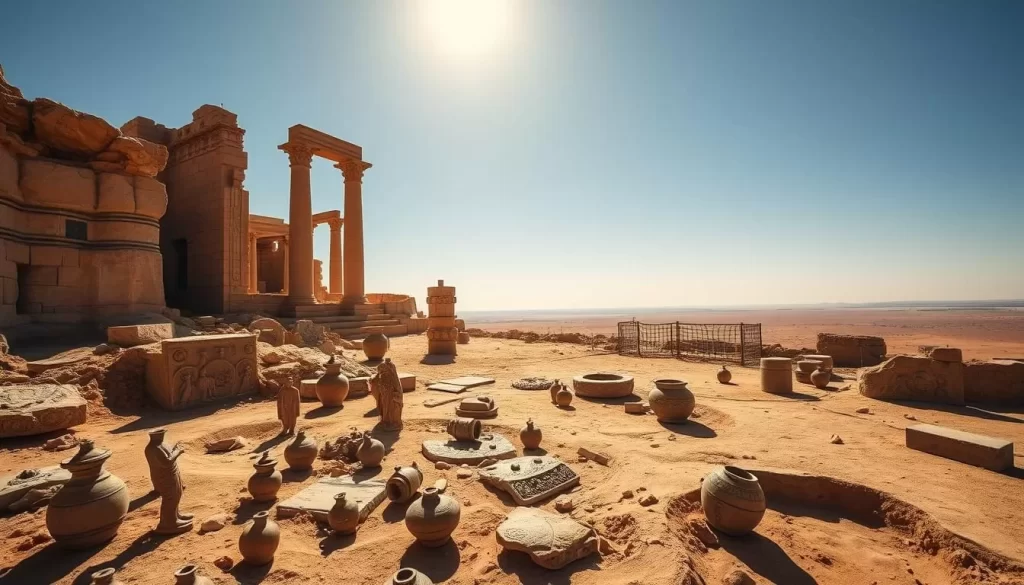
UNESCO has played a crucial role in preserving these treasures. Their efforts focus on restoring and protecting the city’s heritage, ensuring it remains a vital part of global history. Despite challenges like looting and destruction, the work continues to safeguard this place for future generations.
Insights from UNESCO Heritage Efforts
UNESCO’s restoration projects highlight the importance of these archaeological finds. They not only preserve history but also boost tourism, bringing tourists from around the world. The local community benefits from these efforts, as they gain a deeper connection to their heritage.
One of the most significant discoveries includes ancient seals and carvings that reveal the city’s religious and cultural practices. These artifacts are now protected, allowing visitors to experience the richness of this ancient civilization.
Here’s a quick guide to the key artifacts and their significance:
| Artifact | Significance |
|---|---|
| Ancient Seals | Reveal trade and religious practices of the time. |
| Intricate Carvings | Showcase the artistic skills of ancient craftsmen. |
| Grand Structures | Highlight the architectural brilliance of the era. |
For more insights into the preservation of cultural heritage, check out this detailed report. It provides valuable information on the challenges and efforts in safeguarding these treasures.
As you plan your trip, remember to respect the local culture and heritage. These artifacts are not just pieces of history; they are a part of the civilization that continues to inspire us today.
Preparing for Your Trip: Essential Travel Tips
Get ready for an unforgettable adventure with these essential travel tips. Planning ahead ensures a smooth and enjoyable experience, whether you’re exploring ancient ruins or navigating bustling cities. Here’s everything you need to know to make the most of your visit.
What to Pack and Practical Advice
Packing smart is key to a stress-free trip. Start with lightweight, breathable clothing to handle the warm weather, especially if you’re visiting during the summer months. Don’t forget a sturdy pair of walking shoes for exploring historical places.
Essential items include sunscreen, a reusable water bottle, and a first-aid kit. If you’re traveling to areas near marshes, consider packing insect repellent. A portable charger and a reliable map or GPS device are also helpful details to include.
Navigating Checkpoints and Local Challenges
Traveling through the region often involves passing through multiple checkpoints. Always carry your passport, visa, and any necessary permits. Keep these documents easily accessible to avoid delays.
Be prepared for visible military presence and occasional security checks. A friendly attitude and patience go a long way in ensuring a smooth experience. Hiring a local guide can also help navigate these areas more efficiently.
Managing Weather and Transportation
The weather can vary significantly depending on the season. Plan your visit between September and November or March to May for milder temperatures. Avoid the extreme heat of summer, which can reach up to 60°C (140°F).
For transportation, shared taxis are a cost-effective option, with fares ranging from 10,000 to 25,000 IQD depending on the distance. If you prefer more flexibility, consider renting a car, which costs around $30-$40 per day in Baghdad.
Here’s a quick checklist for your trip:
- Pack lightweight clothing and comfortable shoes.
- Carry essential documents and keep them accessible.
- Plan for weather conditions and bring necessary gear.
- Use reliable transportation options and consider hiring a guide.
By following these tips, you’ll be well-prepared for an enriching and hassle-free journey. Safe travels!
Conclusion
Conclude your journey with a deeper appreciation for a place where history and culture intertwine. This ancient city offers a unique blend of experiences, from grand temples to intricate carvings, making it a must-visit destination for any traveler.
As you plan your visit, remember to prioritize security and respect local customs. The preservation of this cultural heritage is vital, and your mindful exploration helps ensure its legacy for future generations. Whether you’re capturing a memorable photo or enjoying a meal at a local restaurant, every moment adds to the richness of your experience.
Share your stories and continue exploring neighboring historical marvels. This civilization has much to offer, and your journey is just the beginning. Plan your trip today and immerse yourself in the timeless allure of this remarkable place.
The above is subject to change.
Check back often to TRAVEL.COM for the latest travel tips and deals.
